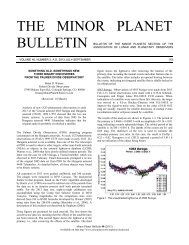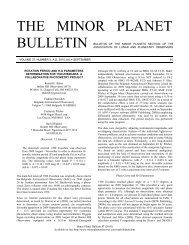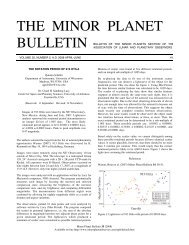THE MINOR PLANET BULLETIN - MinorPlanet.Info
THE MINOR PLANET BULLETIN - MinorPlanet.Info
THE MINOR PLANET BULLETIN - MinorPlanet.Info
- No tags were found...
Create successful ePaper yourself
Turn your PDF publications into a flip-book with our unique Google optimized e-Paper software.
83<br />
OBSERVER & OBSERVING NO.<br />
<strong>PLANET</strong> APERTURE (cm) PERIOD (2008) OBS.<br />
162361 2000 AF6 Harvey, 73 Dec 23 6<br />
162900 2001 HG31 Harvey, 73 Oct 21 3<br />
164400 2005 GN59 Faure, 20 Aug 30 2<br />
Harvey, 73 Sep 18 6<br />
170891 2004 TY16 Faure, 20 Feb 8-9 6<br />
Harvey, 73 Feb 3 6<br />
179806 2002 TD66 Harvey, 73 Feb 28 6<br />
187026 2005 EK70 Harvey, 73 Feb 21 6<br />
199003 2005 WJ56 Bookamer, 41 Jan 8 8<br />
Harvey, 73 Jan 12 6<br />
Hudgens, 32, 30, 25 Jan 6-12 7<br />
2005 WY3 Harvey, 73 Mar 10 3<br />
2006 DU62 Harvey, 73 Feb 15 6<br />
2006 SZ217 Harvey, 73 Nov 24 6<br />
OBSERVER & OBSERVING NO.<br />
<strong>PLANET</strong> APERTURE (cm) PERIOD (2008) OBS.<br />
2006 VB14 Harvey, 73 Dec 8 6<br />
2007 TU24 Bookamer, 41 Jan 29-30 8<br />
Faure, 20 Feb 3 5<br />
Harvey, 73 Feb 3 6<br />
Hudgens, 41 Jan 30 3<br />
2008 CL1 Harvey, 73 Mar 2 6<br />
Hudgens, 41 Mar 5 3<br />
2008 CN1 Harvey, 73 Feb 15 6<br />
2008 EV5 Harvey, 73 Dec 22 6<br />
2008 ED8 Harvey, 73 Mar 10 6<br />
2008 QS11 Harvey, 73 Oct 1 6<br />
2008 TT26 Harvey, 73 Oct 21 6<br />
2008 UE7 Faure, 20 Dec 8 4C<br />
Harvey, 73 Dec 4 6<br />
LIGHTCURVE ANALYSIS OF 1125 CHINA<br />
Kenneth T. Menzies<br />
Tigh Speuran Observatory<br />
Framingham, MA, USA<br />
kenmenstar@gmail.com<br />
(Received: 2009 Feb 19 Revised: 2009 Mar 15)<br />
Asteroid 1125 China was observed photometrically from<br />
Tigh Speuran Observatory in 2009 February. The<br />
synodic period of the lightcurve was found to be 5.367 ±<br />
0.002 h and the amplitude 0.38 ± 0.02 mag. Also found<br />
were the absolute magnitude, H = 11.26 ± 0.19, and<br />
phase slope parameter, G = 0.018 ± 0.25.<br />
The asteroid 1125 China was selected for study on the basis of no<br />
record of previous lightcurves according to Harris and Warner<br />
(2009). Observations were collected over four evenings during<br />
2009 February 14-18 resulting in six data sets and 498 data points.<br />
An additional set of data was collected on 2009 March 4 to expand<br />
the phase angle for calculation of H and G parameters (absolute<br />
magnitude and phase slope parameter, respectively). Images were<br />
taken using an f/4 0.2-m Schmidt-Newtonian and SBIG ST7 XME<br />
CCD camera operating at -30º C. Exposures were 120 seconds<br />
using a Schuler Clear filter. Target S/N ratios ranged from 37-55.<br />
Images were calibrated in CCDSoft V5 using bias, dark and flat<br />
frames. Phased lightcurves and periods were generated using the<br />
Fourier Transform tool in MPO Canopus V9.5.0.8. H-G<br />
parameters were calculated using the tool provided in Canopus.<br />
Two Canopus sessions were created to include images collected<br />
on either side of the meridian during a given night. An astrometric<br />
auto-match was conducted, which identified the asteroid target and<br />
many comparison stars from the UCAC2 catalog. The target<br />
magnitude was calculated on the basis of 2MASS catalog stars that<br />
yielded acceptable photometric residual errors (< ± 0.2). This<br />
magnitude is not directly comparable to a standard system but is<br />
relatively accurate as a result of comparison to multiple known<br />
stars of various color indices. The Canopus lightcurve wizard was<br />
used to generate a lightcurve for all images in each of six sessions.<br />
Since each session may have a slightly different zero point due to<br />
the use of different comparison stars, the curves were adjusted to<br />
yield similar differential magnitudes, with a comp adjust, for<br />
identical portions (i.e., maximum light) of the lightcurve. After<br />
each session lightcurve was aligned, the Canopus period analysis<br />
tool, using the Fourier algorithm (FALC), (Harris et al. 1989), was<br />
used. This procedure was run iteratively to reduce the range of<br />
assumed periods through reduction of the period interval size, and<br />
increase of the number of period steps. The phased period plot<br />
facilitated the refinement of the period analysis. The synodic<br />
period was determined to be 5.367 ± 0.002 h. The amplitude was<br />
found to be 0.38 ± 0.02 mag.<br />
The H-G system of absolute magnitude (H) and phase slope (G)<br />
parameters (Bowell et al. 1989) were also tabulated using the<br />
Canopus H-G calculator. The H value is the standard Johnson V<br />
magnitude of the asteroid when moved to a hypothetical unity<br />
distance from both the Sun and Earth and viewed at 0º phase<br />
angle. The standard V magnitude for a similar lightcurve point<br />
(i.e., maximum) from each session was calculated by using the<br />
Quick Binzel tool in MPO PhotoRed. Three selected images from<br />
each session were used for this calculation. The target and three<br />
standard 2MASS V comparison stars were identified. By using<br />
known color transforms previously determined for the system’s<br />
clear filter and an assumed V-R color index of 0.45 for asteroids, a<br />
standard V magnitude for 1125 China was determined for each<br />
session. The eight standard V magnitudes were entered into the<br />
H/G tool in Canopus. The tool calculates asteroid distances to the<br />
Sun (R) and Earth (r) as well as phase angle on the basis of<br />
MPCORB elements. The standard V magnitudes are transformed<br />
to reduced unity magnitudes on the basis of V r = V s - 5.0 log (Rr).<br />
The value of H was determined using the FAZ algorithm (Bowell<br />
et al., 1989) implemented in the Canopus H-G tool. The absolute<br />
magnitude H was determined to be 11.26 ± 0.19, which is<br />
statistically identical to the value of 11.2 reported by the Minor<br />
Planet Center.<br />
The phase slope parameter (G) was also calculated using the<br />
reduced magnitude and phase angle data. The G value models the<br />
asteroid’s brightness with decreasing phase angle, including the<br />
“opposition effect” which is a non-geometric brightening near<br />
opposition. Initially, an assumed value of G (0.15) is used to<br />
calculate H. If data are available from both small phase angles<br />
(










